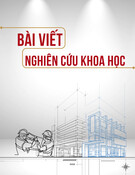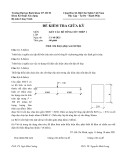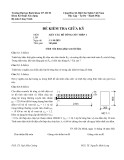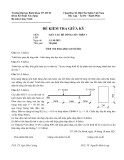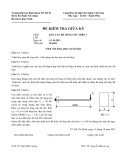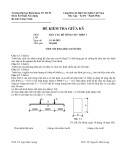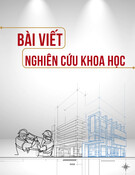
Journal of Science and Technique - ISSN 1859-0209
121
VERTICAL GROUND MOTION EFFECTS ON THE INTERNAL
FORCES IN REINFORCED CONCRETE STRUCTURES
Van Luong Ha1, Van Tu Nguyen1, Xuan Dai Nguyen1, Hoang Nguyen1,*
1Institute of Techniques for Special Engineering, Le Quy Don Technical University
Abstract
This article investigates the effects of vertical ground motion on the seismic responses of
reinforced concrete (RC) structures. Conventional seismic design primarily focuses on
horizontal ground motions, often neglecting the significant impacts of vertical accelerations.
This study begins with a comprehensive analysis of the characteristics of vertical ground
motion, thereby enhancing the understanding of these loads. A numerical analysis is
performed on a typical multistorey RC building model to evaluate the impact of vertical
ground motion on internal forces, specifically axial forces in column elements and bending
moments in beam elements. The findings show that vertical ground motion can result in
substantial increases in internal forces, which may necessitate revisions to current design
practices. This study emphasizes the importance of considering vertical ground motion in the
seismic-resistant design of RC structures to ensure safety and structural integrity.
Keywords: Seismic analysis; elastic response spectrum; vertical ground motion; reinforced
concrete building.
1. Introduction
An earthquake is the shaking of the Earth's surface caused by an unexpected release
of energy within the lithosphere, which generates seismic waves. There are three main ways
that these seismic waves travel, and each has a particular effect on structures such as [1]:
- P-waves (Primary waves): These are compressional waves that move through the
Earth in a push-pull motion, expanding and compressing the material in their passageways.
- S-waves (Secondary waves): These shear waves cause particles to move
perpendicular to the direction of motion, generating shaking that is either up and down or side
to side.
- Surface waves: These waves travel along the Earth’s surface and typically cause
the most damage during an earthquake. They include Love waves (the waves move
horizontally in a side-to-side motion, creating a rolling effect) and Rayleigh waves (the
waves produce an elliptical rolling motion similar to ocean waves, causing both vertical
and horizontal ground movements).
* Corresponding author, email: hoangnguyen@lqdtu.edu.vn
DOI: 10.56651/lqdtu.jst.v7.n02.881.sce





